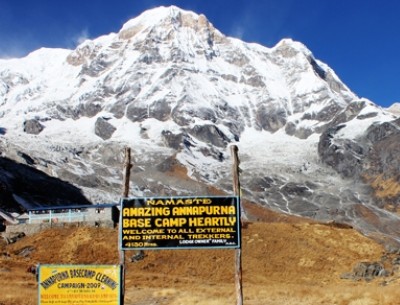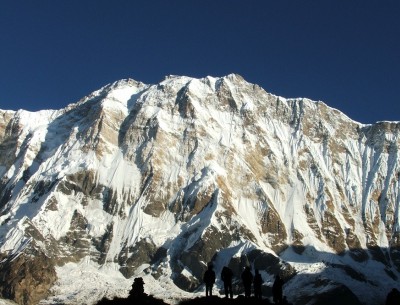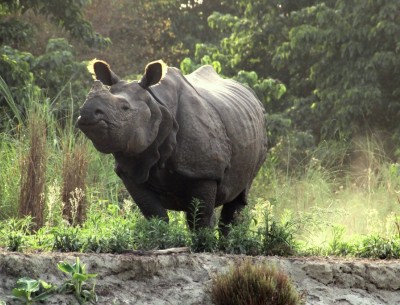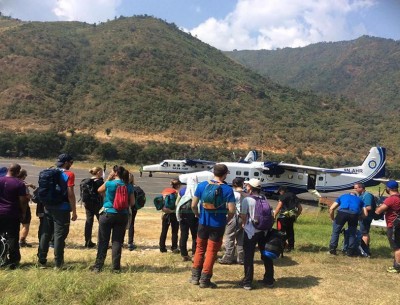Annapurna Base Camp Trek: Complete Guide
‘We wander for distraction, but we travel for fulfillment’- Hilaire Belloc
This quote stated by Belloc encompasses the meaning and purpose behind the revered Annapurna base camp trek. There are many reasons as to why people choose to traverse the Annapurna region. Some may do it for personal reasons, but many do it to give meaning to life and to comprehend the beauty of nature. The Annapurna base camp trek takes place in the majestic Annapurna region, which is touted by travel fanatics and travel magazines as one of the must-visit sites in the world.
You may be wondering what makes this region beautiful?
Your question can be answered with the jaw-dropping views of the mighty Annapurna mountain ranges and the immense gorge that is carved by the thunderous Kaligandaki river. As you venture in the rugged terrains of Annapurna, you’ll witness landscapes that resemble that of Tibet and at times, of dense jungles.
The forests are teeming with life and are home to exotic creatures of all kinds. The people living in these silent corners follow Buddhism, which is influenced by Tibet, and their simplistic approach towards life makes you question what you are doing with yours. A delightful fusion of culture, nature, and never before seen landscape, is what contributes the Annapurna base camp trek.
To fully inculcate in Annapurna Base Camp trek, there are some basic facts that you need to know. In this blog, we shall take a closer look at those facts, and you can use them to make your trip in the mountains memorable and worthwhile.
What sort of permits do I need to go on Annapurna Base Camp Trek?
A majority of the Annapurna base camp trek takes place in the revered Annapurna Conservation Area. This is a restricted area and is protected by the government. To explore the conservation area, you will need two types of permits. The first one is the Trekking Intelligent Management System (TIMS) card. This can be obtained at Kathmandu or Pokhara.
The cost of this permits depends on whether you are traveling alone or in a group. Individual trekkers need to apply for green TIMS card whereas group trekkers need to apply for a blue TIMS card. Another necessary permit is the Annapurna Conservation Area Permit (ACAP). This can be obtained at the entrance of the conservation area. If you wish to enter Upper Mustang, then you need to have a restricted area permit as well.
Annapurna base camp trekking itinerary
There are many trekking routes that you can use to reach the Annapurna base camp. These itineraries can be customized as per your needs.
However, the most common itinerary out there is:
Day 1: Kathmandu to Pokhara (By flight or Bus)
Day 2: Drive to Nayapul and trek to Ulleri
Day 3: Trek to Ghorepani
Day 4: Early trek to Poon Hill for Sunrise, Back to Ghorepani and Trek to Tadapani
Day 5: Tadapani to Chomrong
Day 6: Chomrong to Dobhan (Dovan)
Day 7: Dovan to Deurali
Day 8: Deurali to Machhapuchhre Base Camp (MBC)
Day 9: MBC to Annapurna Base Camp
Day 10: Trek to Bamboo
Day 11: Trek to Jhinu Danda (Hot spring in Jhinu Danda)
Day 12: Jhinu Danda to Pothana/Jhinu Danda to Ghandruk
Day 13: Pothana to Phedi and drive to Pokhara/ Ghandruk to Nayapul and drive to Pokhara
Day 14: Drive back to Kathmandu
Day 15: Final departure
What sort of equipment do I need to carry during ABC Trek?
This is probably the most asked question in Annapurna base camp trek and any other treks out there. Determining what to carry and what not to carry is a huge task in itself as it can directly affect the quality and nature of the trek.
Here are some of the basic stuff and commodities that you need to carry to make this trek a success:
Lightweight and durable trekking boots
Flip flops or crocs
At least 4 pairs of liner socks
At least 3 pairs of underwear
High quality down jackets
T-shirts and trousers
Light sleeping bag
Thermal wears
Trekking poles
Warm pair of gloves
Torchlight and headlight
Toilet items (wet wipes, toilet paper, sanitary pads, sunscreens, lip balms, moisturizers, etc)
Sunglasses
First aid kit that includes ORS
Some light snacks like chocolate, cards, and IPAD
When is the best time to take the Annapurna base camp trek?
To explore the Annapurna Base Camp, you need to be mindful of the prevailing weather conditions, and you need to understand at which time it is suitable to travel. There are 4 seasons in Nepal. They are Spring (March to May), Summer (June to August), Autumn (September to November), and Winter (December to February).
Autumn is considered by many to be the best season to take this trek. This is a dry season, and it provides a clear picture of the blue skies. Also, the temperature is moderate. This is the best season to take any sort of trek in Nepal. The only drawback is that the route tends to be crowded.
There are options of taking this trek in winter, but the serious drawback is that you won’t get to witness amazing views and the temperature may fall below zero. During summer, the path is prone to landslides and avalanches, and at some parts, the trail is inaccessible. Another best season to explore the Annapurna region is during spring as the forests boom to life, and the rhododendron forests welcome travelers.
Where will I be staying during the trek?
As with numerous popular trekking routes, you can find small lodges and teahouses in Annapurna base camp trek as well. The most favored alternative is a teahouse. It means residing in the house of a local person who lives there. These teahouses do not offer anything fancy, but they are filled with the necessities.
Depending upon the severity of the trek, some tea houses will not have facilities like hot shower and internet. This sort of teahouses can be found in the high Himalayas. In most of the teahouses, you will find a simple bed, toilet, and if you are lucky wifi. Living in a teahouse will let you get an inside look as to the lives of the individuals plus they do not cost much as well.
What will I eat during the Annapurna base camp trek?
During this journey which spans more than 2 weeks, you will dine on typical Nepali food, which consists of dal, bhat, dhido, and sel roti. Only in the major cities will you be able to eat international cuisines. Even common Nepali items like Momo and Chowmin are a rarity in these parts and may cost much. You won’t find stores that sell luxurious food items. So, if you get any sort of cravings, then we advise you to carry food along with you.
What sort of costs will I incur?
Traveling in the high Himalayas can be a bit costly. Not only will you be spending on food and accommodation, but you will also be incurring some small costs, which although may seem irrelevant at first, but if you look at them as a whole, then they form a big part of your cost. You might have to pay a bit extra for using electricity to charge your electronic appliances.
Electricity is rare in these parts so you have to pay extra to avail its facility. During the trek, you won’t get the opportunity to shower. There aren’t many shower facilities available so if you find one, then get ready to pay a few extra bucks. At the higher elevation, the tea houses may charge extra for blankets and hot beverages. You can see some outflow here as well.
How difficult is the Annapurna Base Camp trek?
The Annapurna base camp trek is a relatively easy trek that takes you through the high hills of the Annapurna region that later transcend into the high Himalayas. The trail demands that you walk for at least 5 hours a day, but in some parts, you need to walk more than that. Before you take this trek, we advise you that adequately build your stamina and endurance. You can do so by taking jogging and any sort of cardiovascular exercises.
Final verdict
Trekking in the Annapurna region is a milestone rather than a small journey so it is advised that you take it after doing adequate research. It is better to take this trek as a group rather than exploring it by oneself. The fact of whether this trek can be done in a budget depends on a variety of factors.
So, what are you waiting for?
Pack your bags and go on a journey that will provide you amazing memories.
Recent Post
-

Annapurna Base Camp Trek: Complete Guide
Annapurna Region Trekking -

Annapurna Base Camp Fact
Tourism News -

National parks of Nepal
National Parks -

Flight difficulty to luckla from Ramechhap
Domestic flights -

New Tourism Minister in Nepal
Tourism News -

American mountaineer Don Cash dies during Everest descent
Mountaineering
